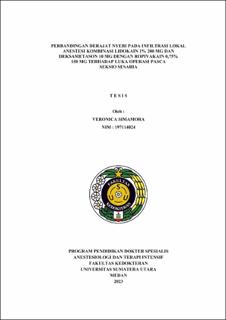Perbandingan Derajat Nyeri pada Infiltrasi Lokal Anestesi Kombinasi Lidokain 1% 200 Mg dan Deksametason 10 Mg dengan Ropivakain 0,75% 150 Mg terhadap Luka Operasi Pasca Seksio Sesaria
The Relationship between D-Dimer/Fibrinogen Ratio with The Severity of Covid-19 in Coronary Heart Disease Patients with Confirmed Covid-19 at H Adam Malik General Hospital in 2021

Date
2023Author
Simamora, Veronica
Advisor(s)
Bangun, Chrismas G
Hamdi, Tasrif
Metadata
Show full item recordAbstract
Background:. Several studies have shown the use of lidocaine to be effective in reducing pain perception compared to placebo. The addition of dexamethasone prolongs the nerve block effect so that the combination of lidocaine and dexamethasone is considered quite effective. Ropivacaine is proven to be able to treat postoperative pain and its effects are felt long enough but this drug is considered quite expensive and not found in all hospitals.
Aim: To compare the degree of pain in the group which given local anaesthetic infiltration of a combination of lidocaine 1% 200 mg and dexamethasone 10 mg with ropivacaine 0.75% 150 mg on post-cesarean section surgery wounds..
Method: This study used a cross sectional design. The study subjects were patients who underwent cesarean section surgery under spinal anaesthesia at the Haji Adam Malik Medan General Hospital and several network hospitals and met the inclusion and exclusion criteria. Both groups were given an intervention of 200mg lidocaine 1% + 10mg dexamethasone and 150mg ropivacaine 0.75% and analysed the degree of surgical wound pain using NRS at rest and passive movement at the 2nd, 6th, 12th and 24th postoperative hours.
Results: Of the 38 samples, there was a significant difference in NRS of the surgical wound between the two groups at rest at 2,6,12 hours (p=0.001; p=0.001; p=0.018) and insignificant (p=0.784) at 24 hours after cesarean section. There was a significant difference in NRS in the lidocaine + dexamethasone group both at rest and passive movement (p=0.001; p=0.001). There was a significant difference in NRS in the ropivacaine group both at rest and passive movement (p=0.001; p=0.001).
Conclusion: There was a significant difference between the infiltration of the combination of Lidocaine and dexamethasone with ropivacaine at hours 2, 6, and 12 both at rest and during passive movements. There was a significant increase in NRS values at hours 2, 6, 12 and 24 at rest and passive movement in the group given the combination of lidocaine and dexamethasone and in the group given ropivacaine.
Collections
- Master Theses [178]
